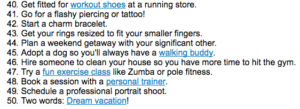
If you say you’re struggling with a new habit, chances are high that someone will tell you to “reward yourself.” Unfortunately, that doesn’t work.
At least, not the way most people do it.
How many times have you told yourself “I get to watch more Netflix when I finish my workout” – and then skip the workout altogether to just watch Netflix?
What about “I’ll get myself that fun new game as a reward when I finish this project” – but then buy the game before the project is finished?
Or even “I can go out with friends once I’m done cleaning” – does the cleaning really always get done first?
If you’re like I used to be, those things happen a lot. They expose some of the problems with how most people use rewards – but you don’t have to be most people.
Fortunately, it’s easy to change.
Why Common Fitness Rewards Suck
Rewards are some of the most studied concepts in psychology. Thanks to operant conditioning, we know how to reward ourselves well. But most people just throw the word “reward” around without understanding the context.
Actually, the Wikipedia article on operant conditioning has a great description of what makes rewards effective. Here’s my short summary – fitness rewards are better when they are:
- Things you want
- Things that happen right away
- Things that you can get only by doing the rewarded action
- Big
And here’s the original, if you’re like me and into that kind of stuff:
Factors that alter the effectiveness of reinforcement and punishment[edit]
The effectiveness of reinforcement and punishment can be changed in various ways.
-
Satiation/Deprivation: The effectiveness of a positive or “appetitive” stimulus will be reduced if the individual has received enough of that stimulus to satisfy its appetite. The opposite effect will occur if the individual becomes deprived of that stimulus: the effectiveness of a consequence will then increase. If someone is not hungry, food will not be an effective reinforcer for behavior.[16]
-
Immediacy: An immediate consequence is more effective than a delayed consequence. If one gives a dog a treat for “sitting” right away, the dog will learn faster than if the treat is given later.[17]
-
Contingency: To be most effective, reinforcement should occur consistently after responses and not at other times. Learning may be slower if reinforcement is intermittent, that is, following only some instances of the same response, but responses reinforced intermittently are usually much slower to extinguish than are responses that have always been reinforced.[16]
-
Size: The size, or amount, of a stimulus often affects its potency as a reinforcer. Humans and animals engage in a sort of “cost-benefit” analysis. A tiny amount of food may not “be worth” an effortful lever press for a rat. A pile of quarters from a slot machine may keep a gambler pulling the lever longer than a single quarter.”
Keeping those things in mind, look at some of the most popular recommendations of rewards for working out. If you need a list to jog your thoughts, try this one from Spark People.

Take a moment to think about those. Do they have the 4 factors that make rewards successful? Which ones are they missing?
Go ahead. I’ll still be here when you get back.
The biggest problems that these fitness rewards have are with factors 2 and 3: they don’t happen immediately and you could get them whenever you want.
That’s why I used to buy my “reward” games before I had actually done anything. It’s also why I used to skip workouts to watch Netflix. If you can get the rewards whenever you want, it isn’t actually a reward for working out; it’s just a nice thing that happens.
Same goes for immediacy. Most of these rewards are things you get when you’ve reached milestones or goals.
But those are the times you barely need rewards!
If you’ve reached a goal, you probably already feel good about yourself. Really, we need encouragement at EVERY OTHER step in the process.
Plus, side note, #45 adopting a dog is hardly something you do on a whim. It takes a lot of work and commitment to care for an animal (although they are adorable, and have helped some people with their fitness).
Same goes for a dream vacation (number 50) – that’s a huge deal. Not the kind of thing that can be used as an everyday reward.
How to Really Use Fitness Rewards
Rewards are an important part of an effective plan and habit. But if common rewards for working out suck, what rewards can you use to actually motivate yourself?
Ever wonder why stereotypical gym bros post shirtless mirror selfies after their workouts? It might seem douchey or like they’re showing off (which, well, might also be true), but to them that’s their workout reward.
Good rewards happen immediately after your workout and are things that you can’t get anywhere else. Because big rewards are hard to do often, I think small rewards are actually more effective.
Plus, there’s some classic research on cognitive dissonance suggesting that big rewards would make you start thinking “I’m only working out for the reward” – and it’s really better if you come to enjoy working out.
A shirtless selfie serves this purpose perfectly: it’s done at the gym (so it’s immediate and related to gym-going), and it comes with immediate social confirmation (compliments).
But say you don’t want to post your mostly naked body on the internet. What other options are there?
Here are 6 of my fitness rewards. Remember, this is what worked to motivate me – your ideal rewards could be very different, but hopefully this list gets you thinking.
- The Grape Juice Shot. This is probably the weirdest one on my list, but it’s also been one of the most effective. I hate stretching, but know how important it is. I love grape juice, but would guzzle the stuff if I drank it regularly. After every stretching session I do a shot of grape juice – and this is the only time I ever drink grape juice. Sound kind of dumb? Maybe it is, but I went from not stretching at all to stretching twice a day, every day.
- The Calendar. This one might be the simplest on the list. Every time I work towards a goal, I put a big check mark on the calendar. It’s a small reward, but it’s so satisfying to see the check marks build up that it keeps me going.
- The Gym Bag Candy. Consider keeping a small supply of nonperishable candy in your gym bag. After your workout, have a piece. The amount of candy is minuscule, and probably doesn’t affect your diet, but the dopamine hit to your brain is very real, and will help you look forward to the gym.
- The Book Store. I love reading, and for a while there was a cool used book store near my gym. If I had time after my workouts, I would go in and browse the stacks. Even if I didn’t buy anything, looking through the new titles was fun and rewarding, and something I only did when I went to the gym (because that’s where the bookstore was!).
- The Stop. Like I said, I love reading. As it happens, there’s a super cool coffee shop halfway between the gym and my apartment. I like to carry a book with me and stop off to read at the shop for a little while on the way home. Another reward I only get by actually going to the gym.
- The Social Time. I’ve used this one in two different ways. First, in college, I used to go to hang out with friends in the athletic building after my workouts. I can’t do that anymore, but during my 20 minute walk home I like to call up some friends to keep in touch. I wouldn’t be doing anything else in those 20 minutes, and my other time is usually filled – this is when I usually talk to them, and I look forward to those talks.
Over to You
You know what makes a good reward. How can you use immediate, desirable, and related rewards to build your fitness habit?

Leave a Reply
You must be logged in to post a comment.